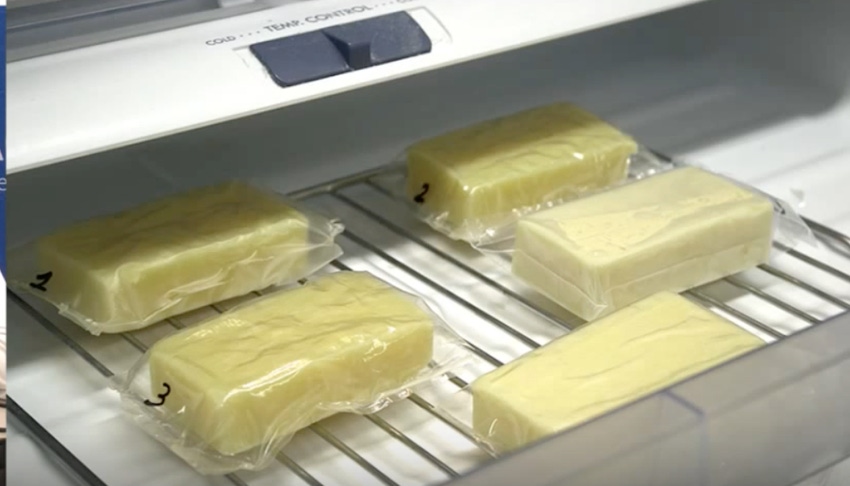Milk-based film—a novel biodegradable, sustainable and edible packaging solution?
August 23, 2016

 Researchers at the U.S. Department of Agriculture presented a novel food packaging solution yesterday at the 252nd National Meeting & Exposition of the American Chemical Society. Looking for a new way to use the excess milk produced in the US, a research team led by Peggy Tomasula, D.Sc and Laetitia Bonnaillie, Ph.D. came up with the idea of creating a new food packaging film.
Researchers at the U.S. Department of Agriculture presented a novel food packaging solution yesterday at the 252nd National Meeting & Exposition of the American Chemical Society. Looking for a new way to use the excess milk produced in the US, a research team led by Peggy Tomasula, D.Sc and Laetitia Bonnaillie, Ph.D. came up with the idea of creating a new food packaging film.
“The excess milk is usually stored in powdered form in bags, as non-fat dry milk,” said Bonnaillie. “The idea was that casein, the main protein in milk, is known to form strong structures – it’s used in glue, paint and it has been used in the past to make plastics. Our idea was to make a thin film of it, to replace potentially plastic wrap.”
Food packaging films made from polyolefins, for example, have poor oxygen barriers, are often difficult to recycle, and some are suspected to even leach compounds into the food products. On January 4th of this year, for example, the FDA banned the use of three perfluorinated compounds (PFCs) in packaging in contact with food. Another example is BPA, the use of which in food packaging has long been a source of controversy. It was concerns of this kind that led the two researchers at the U.S. Department of Agriculture to try to come up with a better solution - made of the milk protein casein
"The protein-based films are powerful oxygen blockers that help prevent food spoilage. When used in packaging, they could prevent food waste during distribution along the food chain," said research leader Peggy Tomasula, D.Sc.
These casein-based films are up to 500 times better than plastics at keeping oxygen away from food and, because they are derived from milk, are biodegradable, sustainable and edible. Some commercially available edible packaging varieties are already on the market, but these are made of starch, which is more porous and allows oxygen to seep through its microholes. The milk-based packaging, however, has smaller pores and can thus create a tighter network that keeps oxygen out.
The researchers' first attempt using pure casein resulted in a strong and effective oxygen blocker, that, however, was relatively hard to handle and would dissolve in water too quickly. They added glycerol, a plasticizer, to eliminate the brittleness; to make it stronger, they incorporated citrus pectin into the blend, which acts as a cross-linker. As a result, the packaging also became more resistant to humidity and high temperatures.
After a few additional improvements, the casein-based packaging now looks similar to store-bought plastic wrap, but it is less stretchy and is better at blocking oxygen. The material is edible and made almost entirely of proteins. Nutritious additives such as vitamins, probiotics and nutraceuticals could be included in the future. It does not have much taste, the researchers say, but flavorings could be added.
"The coatings applications for this product are endless," said Laetitia Bonnaillie. "We are currently testing applications such as single-serve, edible food  wrappers. For instance, individually wrapped cheese sticks use a large proportion of plastic -- we would like to fix that." During the press conference, she demonstrated how a single-serve heat-sealed pouch made of the film and filled with instant coffee dissolved in hot water, “leaving no clumps or taste. Just a little extra protein in the coffee,” she noted.
wrappers. For instance, individually wrapped cheese sticks use a large proportion of plastic -- we would like to fix that." During the press conference, she demonstrated how a single-serve heat-sealed pouch made of the film and filled with instant coffee dissolved in hot water, “leaving no clumps or taste. Just a little extra protein in the coffee,” she noted.
Because single-serve pouches would need to stay sanitary, they would have to be encased in a larger plastic or cardboard container for sale on store shelves to prevent them from getting wet or dirty.
In addition to being used as plastic pouches and wraps, this casein coating could be sprayed onto food, such as cereal flakes or bars. Right now, cereals keep their crunch in milk due to a sugar coating. Instead of all that sugar, manufacturers could spray on casein-protein coatings to prevent soggy cereal. Hydrophilic and grease repellant, the spray also could line pizza or other food boxes to keep the grease from staining the packaging, or to serve as a lamination step for paper or cardboard food boxes or plastic pouches - applications in which the now banned perfluorinated substances used to be used.
Bonnaillie says her group is currently creating prototype film samples for a small company in Texas, and the development has garnered interest among other companies, too. The group plans to keep making improvements, and she predicts this casein packaging will be on store shelves within 3 years.
About the Author(s)
You May Also Like


